Growing and caring for the Venus slipper orchid (papiopedilum) at home (with video)
Temperature. In culture, cold and thermophilic species can be distinguished by their leaves. Plants with pure green leaves require a night temperature of 10–12 ° C. In fact, there is no need for a temperature as low as 10 ° C, it is enough to keep it around 12 ° C. Daytime temperatures should be between 18 and 22 ° C in winter; ideally, in summer, the daytime temperature should be no higher than 24 ° C. However, cold-loving species, like most orchids, will adapt to higher summer temperatures but do better if the temperature does not exceed 30 ° C. When caring for Venus's shoe at home, to protect cold-loving papiopediliums where there is prolonged heat in summer, some growers place plants outdoors, in the shade of large trees. You can place the pots on slag bed or on benches to ensure reliable drainage. It is better to place them higher to block access to snails and worms.

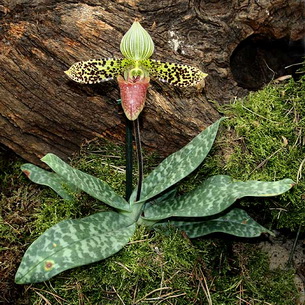
Variegated species and hybrids between them and pure green belong to thermophilic papiopedylums. They prefer night temperatures of at least 15 ° C; temperatures can rise higher in summer. They can be comfortably placed with Cattleya and grown in temperature conditions suitable for Cattleya and their companions.
When caring for a lady's slipper orchid at home, when the peduncle reaches full length and the buds are almost fully developed, you can lower the temperature by two to three degrees. Flowering will be slightly delayed. The temperature must not be lowered too early, otherwise the stalks will remain short and the flowering will not be so beautiful. A slight decrease in temperature allows flowers to stay on the plant longer, so many growers, in order to preserve groups of flowers for as long as possible, lower the temperature by a few degrees after the plants have fully bloomed.
Watering. Since orchids of this genus are continuously growing and do not have pseudobulbs, the substrate should not dry out. The frequency of watering depends on the environment and the substrate used, so it is difficult to give any recipe for all cases. During clear weather, two waterings per week may be sufficient; water less often during cloudy weather. Spraying is usually not necessary except in hot weather. Always water thoroughly so that the water flows through the drain holes in the bottom and flushes out excess salts, as salt build-up is harmful to the roots.
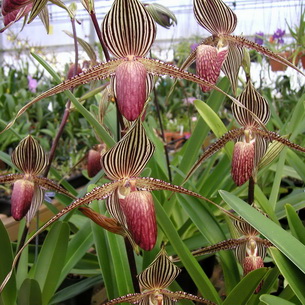
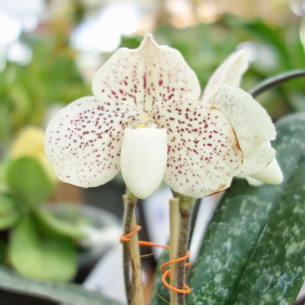
Light. Paphiopedilums thrive best in low light conditions. In winter, when the days are short and the light is slanted from the south, they need about 10,000 - 15,000 lux. When the days are lengthening, shading should be applied to bring the illumination down to 8000-9000 lux. During extreme summer heat, the illumination can be reduced even to 7000 lux. Let the plants themselves be your advisors. Clean leaves with a good green hue indicate optimal lighting, yellow-green leaves indicate that the plant is receiving too much light. Variegated species can be even with more contrasting stripes and specks.
Fertilizers. Paphiopedilums are arguably more susceptible to overfeeding than other orchid varieties. If the salt content of the substrate is too high, root growth is reduced or, in extreme cases, stops altogether. Osmunda fibers do not require additional feeding. This is one of the reasons why osmunda is considered the best substrate for this genus; all you have to do to get good growth is to water diligently. In mixed composts, fertilizing is useful, apparently, no more than once a month, with thorough watering with clean water in between fertilizing.In clean bark, fertilize should be applied every second watering. Again, rinse the substrate thoroughly during intermediate watering. If root growth stalls with fertilization, try reducing the frequency of fertilization by increasing the number of clean water applications between feedings.
The video "Caring for Pafiopedilum at Home" shows how to grow this orchid:
Healing properties
The flower is used for the manufacture of antispasmodics and antiepileptic drugs. It can also be used as a pain reliever for headaches and psychosomatic heart pains. As a psychotropic, preparations from the cuckoo's shoe flower are used to treat depression, insomnia, anxiety and fears.
In gynecology, this plant helps to normalize the menstrual cycle, restore the uterus after childbirth, and stop bleeding.
Important! Preparations from this generally poisonous plant are contraindicated in children, lactating and pregnant women, as well as in patients with renal-hepatic insufficiency.
5 Care
Systematic care of the lady's shoe involves the mandatory maintenance of sufficient soil moisture, but without stagnant water. Spraying is carried out in the heat.
Top dressing during the growing season is carried out monthly. A special liquid mineral complex is used, which is recommended for flowers. You can alternate with the introduction of mullein solution.
For plants grown in containers, a transplant is carried out in the spring. In the open field, this procedure is recommended at intervals of five years. The most suitable period is mid-August.
For wintering, planting is covered with leaves. The containers are dug into the ground with foam plates on top and sides. The lady's slipper shows good disease resistance. A spider mite may appear from pests. Sometimes the plant damages the mealybug. At the first sign, treatment with special preparations is carried out. For example, the biological insecticide "Fitoverm" will help. The drug "Actellik" effectively destroys spider mites. For mealybugs it is recommended to use Mospilan.
Despite some difficulties, you can grow a lady's slipper yourself. This sophisticated variety of orchids, with proper care, will decorate any summer cottage or garden plot.
Types of papiopedilum or lady's shoe for the house
- Paphiopedilum venustum. Dinkum
- Paphiopedilum tranlienianum. Dinkum
- Paphiopedilum sukhakulii. Orchi
- Paphiopedilum rothschildianu. Naoki takebayashi
- Paphiopedilum purpuratum. Orchi
- Paphiopedilum parishii. Orchi
- Paphiopedilum moquetteanum. Naoki takebayashi
- Paphiopedilum liemianum. Daderot
- Paphiopedilum leucochilum. Orchi
- Paphiopedilum lawrenceanum. Naoki-Takebayashi
- Paphiopedilum hirsutissimum. Orchi
- Paphiopedilum henryanum. Orchi
- Paphiopedilum hangianum. Felix
- Paphiopedilum gratrixianum. Averater
- Paphiopedilum glaucophyllum. Secundum naturam
- Paphiopedilum fowliei. Averater
- Paphiopedilum fairrieanum. Dalton holland baptista
- Paphiopedilum exul. Averater
- Paphiopedilum druryi. Orchi
- Paphiopedilum dianthum. Orchi
- Paphiopedilum delenatii. Orchi
- Paphiopedilum dayanum. Naoki takebayashi
- Paphiopedilum concolor. Orchi
- Paphiopedilum charlesworthii. Orchi
- Paphiopedilum callosum. snotch
- Paphiopedilum braemii. Orchi
- Paphiopedilum bellatulum. Orchi
- Paphiopedilum bellatulum. Orchi
- Paphiopedilum barbigerum. BotBln
- Paphiopedilum acmodontum. Averater
Views:
89
Home care
Like all orchids, the Slipper is a very demanding, capricious plant that requires a lot of attention and care.
Seat selection
The Slipper Orchid is best placed on north, east or west windows. On the south window, the flower should be shaded. On the other hand, keeping orchids outside the window is also not recommended. In this case, it is necessary to artificially illuminate them for 10 to 12 hours a day.
Important! If the leaves turn reddish, the light becomes too intense, the plant should be shaded.
Soil preparation
You can buy a ready-made substrate or prepare it yourself.
To do this, you will need:
- 5 parts of chopped pine bark;
- 1 part charcoal;
- 0.5 parts of dolomite flour and perlite;
- 1 part peat.
If the soil retains moisture well, then it is advisable to exclude peat from such a mixture. Often the substrate is made using pine bark, chopped fern roots, sphagnum and charcoal.
Temperature
The slipper can refer to both frost-resistant and heat-loving plants, depending on the variety. Heat-loving species are Callusa and Sukhakula, and Milenky is a cold-resistant variety. All variegated varieties are thermophilic. Varieties and hybrids with rounded large flowers also require heat.For them, the temperature regime of the content should be within + 23 + 28 C in the summer and from +18 to + 23 C in the winter.
Cold-resistant varieties are characterized by wide dark leaves and need a temperature of about + 18 + 22 ° C in summer and + 16 + 19 ° C in winter. When growing any orchid, remember that the temperature at night should be 3-5 degrees below the daytime. When the temperature drops to + 4 or below, the plant dies. In the summer, the orchid needs regular ventilation at least once a day, but without drafts.
Humidity
The slipper is a tropical plant. Therefore, air humidity is very important for him. It should be at least 70-80%. It is not recommended to spray the plant. To increase moisture, you can use a special humidifier or place the plant in a shallow container filled with wet moss, expanded clay, or pebbles.
Lighting
The slipper is a fairly light tolerant plant, but still prefers bright and diffused light without direct sunlight. The duration of daylight must be at least 14 hours per day. The most demanding of these orchids is lighting during flowering.
In winter, be sure to use additional lighting with fluorescent lamps for 2-3 hours.
Watering
This is a very moisture-loving orchid that does not tolerate drying of the substrate. But waterlogging the soil is also not worth it. During the period of active growth, watering should be increased, and after flowering, it should be reduced.
It is important to ensure that the substrate is always moderately moisturized. Irrigation water should be boiled, clean, soft and warm enough (about 30 ° C)
You cannot water the plant at the root. Water should never come into contact with the outlet and the leaves of the plant.
Proper watering is placing the backed container in a wide pot of water. If the substrate consists of large fragments of the bark, then this procedure will take from 30 to 50 minutes. If there are small parts of bark and peat in the ground, then watering is reduced to 10-15 minutes.
Top dressing
You need to feed this orchid regularly, once a month. During flowering and active growth, the frequency of feeding increases up to 2 times a month. For this, special mineral fertilizers for orchids are suitable, but their concentration should be half the recommended one.
The slipper often suffers from excess salts in the soil. To at least slightly adjust the salt balance, you can water the plant with distilled water once. After that, the next watering with regular water, you can fertilize.
Transplant
The slipper does not tolerate transplantation very well. Therefore, it is necessary to carry out such an operation only if the soil decomposes, but not more often than once every 2-3 years, in the spring.
Orchid roots grow horizontally, so the pot is very wide and shallow
Repot the plant after flowering and be very careful not to damage the roots. After transplant, do not water for 3-4 days
Let's take a look at how to properly transplant the Slipper Orchid:
Orchid Care Venus Slipper
Paphiopedilums can be kept in potted culture on windowsills. Different types of paphiopedilum prefer cool, moderate or warm conditions. Variegated species, as well as species and hybrids with rounded large flowers, are thermophilic. Orchid care The lady's slipper of tropical species must be kept at a temperature of + 20 ... + 22 ° C. In summer, especially at night, the room with the plant must be ventilated. For placement, a well-lit, sunny place is chosen, with shading at noon hours; in winter, artificial supplementary lighting is useful (12 hours a day). In summer, it is recommended to keep the plants outdoors in the home.
Watering is uniform and moderate; the substrate should dry out between waterings. In winter, after the flowering of the indoor Venus shoe, watering and humidity are reduced.During the heating season, when caring for the Pafiopedilum orchid, it is recommended to use a humidifier instead of spraying.
During growth, regular feeding is required every two months. After 2-4 years, the plant must be transplanted into fresh soil. Indoor plants Venus slipper are usually grown in ceramic or plastic, the top of which is wider than the bottom. This is necessary so that during transplantation it is possible to remove the plant from the dishes without damaging its fragile roots. Venus's shoes are planted in containers, in a mixture of bark and peat (2: 1) with the addition of dolomite flour.
Paphiopedilums are propagated by dividing the bush. When dividing, make sure the outlets are rooted.
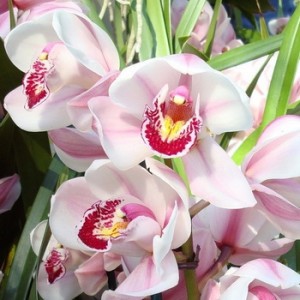
Genus Slipper (Cypripedium)
Orchid family
Lady's slipper is real
(Cypripedium calceolus L.j) is one of the most beautiful orchids in the temperate zone. Perennial plant 25-50 cm high with articulated creeping root shoots. Grows in coniferous and mixed forests. Prefers well-moistened soils, but can grow in drier places. Has a thick rhizome. The stem and four broadly oval leaves are covered on both sides with short hairs.
Lady's slipper blooms in May - June with large single flowers of irregular shape. Two inner brownish-red lateral petals are lanceolate, diverging to the sides. The third petal (sponge) is light yellow, convex, dotted with red dots inside. The fruit is a single-chambered capsule with 6 folds. Propagated by seeds and vegetatively using rhizomes. Seeds are small, numerous, with an underdeveloped embryo.
It is important! Lady's slipper is real
- a protected species listed in the Red Data Books of the Russian Federation and the Belgorod Region (category of rarity status I - endangered species). Seed germination occurs only in the presence of a certain fungus and with sufficient moisture
For the first three years, the sprout of the shoe leads an underground lifestyle, feeding on the fungus. In the fourth year, the first green leaf develops. The slipper blooms, usually at the 15-17th year of life, and in favorable conditions - at the 8th year. Generative shoots are usually 10-30%, flowers are pollinated with the help of flies, beetles, bees and other insects. The fruit setting rate is low. In this regard, seed reproduction of the present shoe is rarely observed. Especially quickly this plant disappears in densely populated areas. The plant is medicinal. In case of headache, they drink an aqueous extract of the herb and at the same time cover the head with fresh leaves.
It is interesting!
The name of the plant consists of two words: Greek cypripedium - Cypride's slipper (Aphrodite, Venus) and Latin calceolus - small slipper. The people call the flower a drape overshoe (drape means good, solid). It is also called Maryin's shoe, cuckoo's boots
The secret of the unusual name is revealed
When you look at the fancy buds of a delicate orchid, you involuntarily wonder: where does this name come from - the lady's slipper. Interesting facts show that the secret lies in ancient legends.
Once the Roman goddess Venus went hunting with her beloved Adonis. It started to rain quite unexpectedly. To hide from him, they went into a cave, where it was dry and warm. The goddess threw her wet shoes at the entrance and was carried away by communication with Adonis. At this time, a poor peasant passed by. Seeing the beautiful shoes, he wanted to take them for himself. But as soon as he touched them, they turned into graceful flowers. He realized that the gods were hiding in the cave. Throwing orchids near the cave, he left. Since then, Venus shoes of various colors and shades have been growing on the earth. Of course, this story was made up by people, but the beautiful name matches the original colors.
Caring for papiopedilum (lady's shoe) at home
Temperature
Pafiopedilum is divided into four categories in relation to temperature levels.
- Heat-loving: Summer temperature is within + 22-27 degrees, winter temperature is + 17-20. This category includes all papiopedilums with spotted leaves.
- Moderately thermophilic: + 20-23 degrees in summer, + 17-20 degrees in winter. The most popular and most numerous category. All multiflorous species of papiopedilum belong to it. These are the very species that can bloom for a whole year, thanks to the "revolving" nature, replacing faded flowers with new ones.
- Neutral: + 20-22 degrees in summer, + 16-19 degrees in winter. Paphiopedilums with green narrow leaves fall into this category.
- Moderately cold-loving: Summer temperature + 18-22, winter + 15-18 degrees. This group includes papiopedilums with wide leaves.
Advice. Like the vast majority of orchids, the Venus shoe needs a temperature difference. This means that the nighttime temperature should be at least three degrees below the daytime. Usually, it is not particularly difficult to create such a temperature difference at home, especially during the cold season. In summer, starting from mid-May, papiopedilum can be moved to fresh air, protecting it from strong sun, wind and rain.
Lighting
Almost all species of this orchid will prefer a well-lit location. But there may be special preferences depending on the species. Basically, this applies to multifloral papiopedilums and having a uniform green color of the leaves. They need more light. A certain amount of direct sunlight in the morning and evening will not hurt either. In the midday heat, they need to be shaded. Pafiopedilum in which the leaves are spotty in color and paphiopedilum small-flowered can easily grow at the northern window, in partial shade.
Advice. Despite the varying light requirements, duration of light is important for all of these orchids. It should be about 14 hours a day. At home, it is almost impossible to provide such long-term lighting in a natural way. Therefore, you will have to resort to artificial lighting.
Watering
Regardless of the season, watering paphiopedilum should be regular and even. It is best to water it, like other orchids, by immersing it in a container of water until the substrate is completely saturated with moisture.
Advice. It is impossible to overdry the substrate, as well as to fill
But pay special attention to the quality of the water. It should be soft, distant and have a temperature 3-4 degrees above room temperature.
Air humidity
Like all people from the tropics, papiopedilum requires high humidity. At the same time, the proportion is observed - the higher the air temperature, the higher the percentage of humidity should be. If, for example, at a temperature of +23 degrees, 50% humidity is sufficient, then when the temperature rises to +25 degrees and above, 70% humidity is already needed. To solve the problem with high humidity for papiopedilum, you can use a humidifier, but at low temperatures, less costly, folk methods will also help (read "about air humidity").
Top dressing
Although it is believed that a lady's slipper can be fed with half a dose of fertilizer for flowering plants, it is still better to purchase and use a special fertilizer for orchids. The frequency of fertilizing is indicated in the instructions for fertilization, but usually it is once every 21-30 days.
Transplant and substrate
It is not necessary to transplant pafiopedilum without special need. He does not like, and does not need frequent, planned transplants. Transplant only in cases where the orchid has grown strongly and no longer fits in the pot, when the substrate has become unusable, caked, crumbles into dust, or in emergency cases (illness, waterlogging with root decay, etc.). As for the substrate for papiopedilum, one should not be too smart, but just buy a ready-made one. This is especially true for novice growers who do not have specific experience. An improperly formulated orchid mixture can kill the plant.
For the curious, I can tell you that the soil for the Venus's shoe usually consists of pine bark, peat, perlite and charcoal.
You can read more about transplanting - "How to properly transplant orchids".
Reproduction
At home, papiopedilum can be propagated exclusively vegetatively, by dividing the bush. But you should not immediately separate the young plant. Let him grow a little and acquire at least three leaf rosettes.
Successful cultivation and abundant flowering!
How to care for a lady's shoe ↑
Caring for this flower is quite simple. The main thing is to ensure that the soil always remains moist. During the dry period, the plant needs to be watered, but carefully, without causing waterlogging.
With regard to fertilization, a very metered application of mineral fertilizers is recommended. Only in spring and only low concentration, a quarter of the norm. Their more frequent use can lead to the appearance of a large number of young shoots that will not have time to mature before the onset of the autumn cold. This can kill the plant.
Any manipulations near the root of the shoe, such as loosening the soil, removing weeds, must be done very carefully.
It is important not to damage the root, especially young buds, which are laid very close to the surface of the earth. If damaged, the orchid can "fall asleep" (more on this below)
It is better not to uproot the weeds, but to prune them at ground level, which will lead to their gradual depletion.
The place where orchids grow should be protected, for example, by surrounding stones around the perimeter. It is also very good to cover it with a coarse mesh, rigid mesh to protect it from animals.
What conditions are needed for growing a shoe?
Since there are actually a lot of shoe varieties, there are no uniform conditions for growing this flower. It is only indispensable that they should be as close as possible to the natural growing conditions. Among the cypripediums, there are plants adapted to different growing areas - these are orchids that grow on trees, and plants that are more free on stones and rocks, there are also those that prefer simple humus
Therefore, it is very important to know which species is more suitable. The soil in which the shoe is planned to be planted must certainly be moderately alkaline, moist and with good air filtration.
These flowers love both sunlight and shaded places.
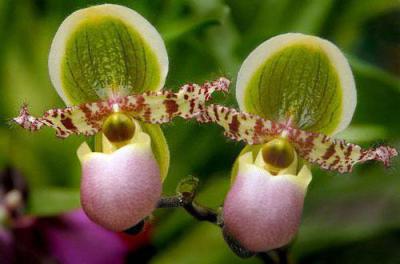
But there is one more side that unites different subspecies of the shoe - almost all of them are frost-resistant.
The large-flowered slipper does not require special care - the plant is considered not whimsical at all. All that is required is regular, moderate watering.
It is important to know that in no case should soil be poured. Just as it is impossible to overdry it - the plant in these cases will certainly die.
If the air is very dry, it is better to spray the shoe periodically, or try to create conditions that allow it to maintain moderate humidity. When the shoe blooms, it is worth feeding it. The best complementary food in this case will be mullein infusion. But you cannot overdo it with mineral fertilizers - they contribute to the formation of salts in the soil, which will also destroy the flower. So, we partially examined the large-flowered slipper - description, types, care.

What else do you need to know about this plant?


